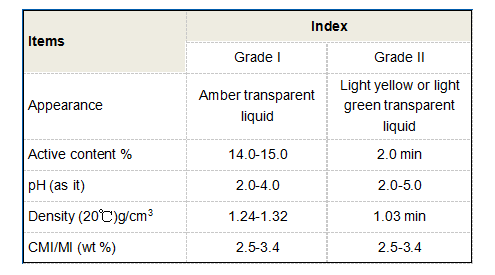chloro methyl isothiazolinone
Chloro Methyl Isothiazolinone Understanding Its Uses and Safety
Chloro Methyl Isothiazolinone (CMI) is an important biocide and preservative commonly used in various industries, particularly in the formulations of personal care products, household cleaners, and industrial applications. This chemical compound, which belongs to the isothiazolinone family, has garnered considerable attention due to its efficacy in preventing microbial growth, but it has also sparked discussions regarding its safety and potential health risks.
Chemical Overview
CMI is often found in combination with another compound, Methylisothiazolinone (MIT), forming a mixture that works synergistically to enhance preservative capabilities. These compounds are particularly effective against bacteria and fungi, making them invaluable in products that require a prolonged shelf life. CMI is commonly employed in formulations such as shampoos, conditioners, body washes, and wet wipes, as well as industrial products like adhesives and paints.
Mechanism of Action
The biocidal action of CMI stems from its ability to disrupt cellular processes in microorganisms. Specifically, it interferes with protein synthesis and enzyme activity, ultimately leading to cell death. This mechanism makes it highly effective at inhibiting the growth of a wide range of bacteria and fungi, thereby ensuring the stability of consumer products over time.
Safety Concerns
Despite its effectiveness, concerns have been raised about the safety of CMI, especially regarding skin sensitization and allergic reactions. In recent years, there has been an increase in reports of contact dermatitis associated with products containing CMI and MIT. As a result, regulatory bodies in various regions, including the European Union, have taken steps to limit the concentration of these preservatives in cosmetic products.
chloro methyl isothiazolinone

The European Commission has classified CMI as a potential skin sensitizer, leading to stricter regulations on its use. The cosmetics industry has responded by formulating alternatives or reducing the concentrations of these compounds in their products, in an effort to mitigate the risk of adverse reactions in consumers.
Regulatory Standards
Globally, the regulation of CMI varies significantly. In Europe, the European Chemicals Agency (ECHA) has placed restrictions on the use of CMI and MIT, particularly in leave-on products due to the heightened risk of skin exposure. Conversely, in the United States, the Environmental Protection Agency (EPA) regulates CMI as a pesticide, meaning its use in industrial settings is subject to a different set of guidelines. This discrepancy highlights the need for continued research and dialogue regarding the safety profiles of biocides like CMI.
Alternatives and Innovations
With the growing concerns regarding the safety of traditional preservatives, many companies are exploring alternative preservatives and preservation techniques. Options such as natural preservatives derived from plant extracts, fermentation products, and even advanced technologies like preservation systems that utilize packaging to protect formulations from contamination are gaining traction. These alternatives often appeal to consumers who are increasingly seeking products formulated with safety and sustainability in mind.
Conclusion
Chloro Methyl Isothiazolinone serves as a crucial ingredient in preserving the integrity of numerous products within the personal care and industrial sectors. While its effectiveness as a biocide is well-documented, the increasing reports of allergic reactions necessitate a careful examination of its safety profile. As consumer awareness grows and regulatory pressures intensify, the industry is likely to continue evolving, seeking safer and more sustainable alternatives to traditional preservatives. Ongoing research and innovation will be key in finding a balance between effective preservation and consumer safety, ensuring that products remain both effective and safe for everyday use.
-
lk-319-special-scale-and-corrosion-inhibitor-for-steel-plants-advanced-solutions-for-industrial-water-systemsNewsAug.22,2025
-
flocculant-water-treatment-essential-chemical-solutions-for-purification-processesNewsAug.22,2025
-
isothiazolinones-versatile-microbial-control-agents-for-industrial-and-consumer-applicationsNewsAug.22,2025
-
scale-inhibitor-key-solutions-for-water-system-scale-preventionNewsAug.22,2025
-
organophosphonates-versatile-scale-inhibitors-for-industrial-water-systemsNewsAug.22,2025
-
scale-and-corrosion-inhibitor-essential-chemical-solutions-for-water-system-maintenanceNewsAug.22,2025





